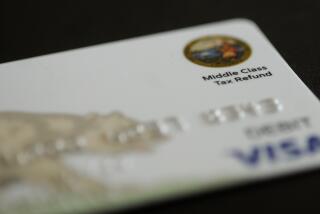Rebates on Credit Cards Can Be Tough to Figure
- Share via
Arthur Krieger makes money when he uses his credit card. The problem is, he doesn’t make enough.
Like many Americans, Krieger has a credit card that pays him a reward, or rebate, based on how much he charges.
Krieger said he spent about $9,000 on his co-branded American Express-Costco card last year and got $89 cash back. But that was about $50 short of what he thought he’d been promised.
After several phone calls, Krieger said he learned that the rebate formula he thought was simple was anything but. He had thought he would get a rebate amounting to 1.5% of his charges. But the rebate formula was tiered, paying 0.25% of his first $2,000 in charges, 0.5% on charges between $2,000 and $5,000 and 1.5% on charges above $5,000.
It was Krieger’s welcome into the often complicated but potentially lucrative world of cash rebate credit cards.
With cash rebate cards, consumers can get something for nothing -- but it’s hard to spot the best deals unless you read the fine print. Moreover, charging purchases to get cash back is only a good idea if you can afford to pay off your monthly credit-card balance in full.
If you carry a revolving balance, you’ll almost certainly pay more in interest than you will get in cash rewards.
“I’m tired of this telling you one thing and doing another,” said Krieger, a Los Angeles resident, who still smarts at the fact that the big-print promises are scaled back in the fine-print details. “This is the second time I’ve had this kind of problem with American Express.”
American Express said it couldn’t comment about Krieger’s account but noted that its rebate formula was spelled out in cardholder documents.
Rebate cards, which refund 1% to 5% of consumer charges in the form of cash or gift certificates, are the latest hot spot in the credit card market-share battle, said Ken McEldowney, executive director of Consumer Action in San Francisco. The cards are offered by nearly all of the nation’s major card issuers.
One reason that the cards have become so prevalent is a shift in consumer attitudes, said David Robertson, publisher of the Nilson Report, a credit card newsletter based in Carpinteria.
In the past, the “must have” reward was airline miles, he said. But consumers now view those with suspicion as airlines place greater restrictions on the use of free miles and people fear that financially struggling airlines may not be around when they are ready to redeem their miles.
“There are a lot of people asking themselves whether they want to turn from their airline card to something new,” Robertson said. “Because market share in the credit card industry is dominated by a handful of huge companies, they all have the wherewithal to dangle a shiny card in front of you.”
That leaves consumers with plenty of choices.
Consider the Discover Card, one of the nation’s oldest cash rebate cards. Its rewards give better returns to those who spend less. Cardholders get 1% cash back on up to $1,500 in annual purchases, but only 0.5% on purchases exceeding that amount.
American Express offers three different cash-back cards, all in cooperation with Costco. The rebates are paid once a year in certificates that can be redeemed at Costco stores for cash or merchandise.
One of those cards -- the one Krieger got -- reverses the Discover formula, rebating the most to those who spend the most. The company’s other two Costco cards have a somewhat simpler rebate formula. On those cards, the rebates amount to 3% of restaurant purchases, 2% on travel charges and 1% on everything else.
There’s no tiered formula with those cards, dubbed “TrueEarnings,” said American Express spokesman Channing Barringer. The full rebate applies to the first dollar charged.
BankOne offers a cash rebate card that pays the cardholder a penny for every dollar charged up to $60,000 per year. Translation: Maximum annual rebate is $600.
Citibank offers a similar card, but it pays a higher percentage -- 5% -- on purchases made at gas stations, supermarkets and drug stores, but caps the annual rebates at $300 a year. However, those who sign up for the company’s “dividend network” can get unlimited rebates on purchases made from Citibank partners in the program, such as clothing retailer Land’s End and Princess Cruises.
“You need a flow chart to figure out which rebate card is best for your use,” McEldowney said. “But, as long as you pay off your balance each month and are careful about how you use the card, there’s no downside.”
The one caution: Some of the cards encourage consumers to carry a balance, he noted. American Express, for instance, pays a “bonus” rebate on some cards to those with revolving balances. But the rebates are never sufficient to compensate for the interest charges, consumer experts agree.
“If you carry a balance, these rewards, whether miles money or gifts, are never worth it,” compared with paying down your debt, said Edmund Mierzwinski, consumer program director at the U.S. Public Interest Research Group in Washington, D.C. “If you are a convenience user, make a decision about which rewards you want. But if you are carrying a balance, the interest you pay far outweighs any benefit.”
*
Kathy M. Kristof, author of “Investing 101” and “Taming the Tuition Tiger,” welcomes your comments and suggestions but regrets that she cannot respond individually to letters or phone calls. Write to Personal Finance, Business Section, Los Angeles Times, 202 W. 1st St., Los Angeles, CA 90012, or e-mail kathy.kristof@latimes.com. For previous columns, visit latimes.com/kristof.
More to Read
Inside the business of entertainment
The Wide Shot brings you news, analysis and insights on everything from streaming wars to production — and what it all means for the future.
You may occasionally receive promotional content from the Los Angeles Times.










